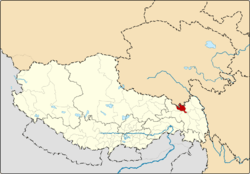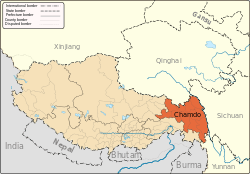Riwoqê County
Riwoche (Tibetan: རི་བོ་ཆེ་རྫོང་།, Wylie: ri bo che rdzong, ZYPY: Riwoqê Zong ; simplified Chinese: 类乌齐县; traditional Chinese: 類烏齊縣; pinyin: Lèiwūqí Xiàn) is a county under the administration of the prefecture-level city of Chamdo in the northeast of the Tibet Autonomous Region, bordering Qinghai province to the north.
Riwoche 类乌齐县 • རི་བོ་ཆེ་རྫོང་། | |
|---|---|
County | |
 Location of Riwoqê County within Tibet | |
| Coordinates (Riwoqê County government): 31°12′42″N 96°36′01″E | |
| Country | People's Republic of China |
| Autonomous region | Tibet |
| Prefecture-level city | Chamdo |
| Time zone | UTC+8 (China Standard) |
Riwoche is the name of the county as well as the name of the county capital and the small village where the main monastery is located. Riwoche sits at around 3,400m above sea level. The Dzi River flows through the region. The county grows barley and wheat. Khampa inhabitants of the area lives in houses made of wood. The area is abundant in mountains and peaks. In contrast to the high altitude grasslands predominant in Tibetan Plateau, Riwoche is lush all year round with evergreen forests. Winters are mild with temperature mostly above -4C whereas summer temperature remains at 20-24 C.[1]
Attractions
Yiri Hot Spring is located at Riwoqê County, surrounded by the hills, is a famous hot spring which is reputed to cure diseases.[2]
Riwoche is also home to the famous Riwoche Monastery, the main set of the Taklung Kagyu,[3] situated 29 km north of the Riwoche Town, and 134 km west of Chamdo.[4]
Jiumichan Monastery is within Riwoqê County, 105 km away from the county seat, is a national key scenic spot.[5]
Naitang Monastery is located at Riwoqê County, with Dingxia Mountain on the back, Naishui River in the front, and Duoji Cliff on the north. Buddhists thought it as the holy land of Ruchi 16 Arhats, called it Naitang Monastery.[6]
Riwoche horses
Riwoche is also known for a unique horse breed called Riwoche horses, thought to be the missing link between modern horses and prehistoric horses after a ground-breaking research in 1995.[7][8][9][10][11][12][13]
Transportation
See also
- Bangru (village)
References
- "Riwoche". The Land of Snows. Retrieved 2019-11-10.
- https://www.mysterioustibet.com/destinations/tibet/qamdo/riwoqe-county
- Taklung Kagyu
- "Riwoche Monastery", Wikipedia, 2019-08-14, retrieved 2019-11-10
- https://www.mysterioustibet.com/destinations/tibet/qamdo/riwoqe-county
- https://www.mysterioustibet.com/destinations/tibet/qamdo/riwoqe-county
- "Riwoche horse", Wikipedia, 2019-09-28, retrieved 2019-11-10
- Riwoche horse - Video Learning - WizScience.com, retrieved 2019-11-10
- Simons, Marlise (1995-11-12). "A Stone-Age Horse Still Roams a Tibetan Plateau". The New York Times. ISSN 0362-4331. Retrieved 2019-11-10.
- "CNN - Tiny, ancient horses found in Tibet - Nov. 17, 1995". www.cnn.com. Retrieved 2019-11-10.
- "Resurrecting the dead". www.downtoearth.org.in. Retrieved 2019-11-10.
- Thomas, Dana (1996-01-08). "PACK ANIMAL OF TIBETAN VALLEY MAY BE HORSE OF A DIFFERENT ERA". Washington Post. ISSN 0190-8286. Retrieved 2019-11-10.
- "Riwoche Horse Info, Origin, History, Pictures". Retrieved 2019-11-10.
